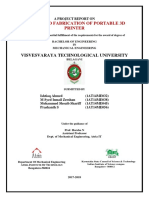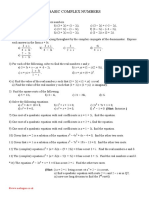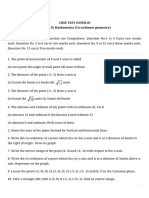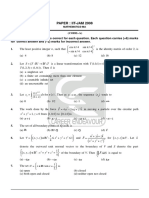OldFinalBv2
Uploaded by
Rangga AlloysOldFinalBv2
Uploaded by
Rangga AlloysM273Q, Old Final B Name:
Instructions: Closed book. No calculator allowed. Show all work and use correct notation to receive full credit!
Write legibly.
1. True or False? Circle ONE answer for each.
True or False: If F is a vector field, then div F is a vector field.
True or False: If F and G are vector fields, then curl (F · G) = curl F · curl G.
ZZ
True or False: If S is a sphere and F is a constant vector field, then F · dS = 0.
S
2. Given the vectors v =< 2, 1, −2 >, u =< 3, 2, 1 >, find the lengths of a and b pictured below:
3. (a) Find an equation for the line through the points (1, 2, 3) and (−1, 5, 4).
(b) Find an equation for the plane that is perpendicular to the line in part 3a and passes through the
point (4, 0, 1).
(c) At what point do the line in part 3a and the plane in part 3b intersect?
x
4. Given f (x, y, z) = :
1 + xyz
(a) At the point (1, 0, 2) in what direction does f increase most rapidly?
(b) At the point (1, 0, 2) what is the rate of change of f in the direction of < 3, −4, 0 >?
dr
5. Given x = r cos θ and that r and θ depend on t in such a way that when t = 0 : r = 2, θ = π/4, =
dt
dθ dx
3, = π, find at t = 0.
dt dt
Z 1Z 1 p
6. Calculate √
1 + y 3 dy dx.
0 x
p ZZZ
7. Let W be the region above the cone z = x2 + y 2 and below the plane z = 1. Calculate x2 +y 2 dV.
W
2
8. Verify that the vector field F(x, y, z) =< 2xy + z, x + 1, x + 2z > is conservative and calculate the work
done by F in moving an object from (2, −1, 1) to (1, 1, 0).
9. Calculate −y 2 dx + xy dy where C is the counterclockwise oriented simple closed curve consisting of
H
C
the piece of the parabola y = 1 − x2 between (−1, 0) and (1, 0) together with the piece of the x−axis
between (−1, 0) and (1, 0).
10. Find the surface area of the part of surface z = xy that lies within the cylinder x2 + y 2 = 1.
11. Let S be the part of the paraboloid z = 4 − x2 − y 2 with z ≥ 0, oriented with
RR upwards pointing normal
vector, and let F(x, y, z) =< −y, x, z > . Using Stokes’ Theorem, calculate (curl(F)) · dS.
S
p
12. Let F(x, y, z) =< y, x, z 2 > and let S bepthe closed surface consisting of the cone z = x2 + y 2 ,
√ √
0 ≤ z ≤ 2, and RR 2 2
the spherical cap z = 4 − x − y , 2 ≤ z ≤ 2. Using the divergence theorem,
calculate the flux, F · dS, of F outwards across S.
S
You might also like
- National Institute of Technology Calicut Department of Mathematics MA 1001D: Mathematics 1No ratings yetNational Institute of Technology Calicut Department of Mathematics MA 1001D: Mathematics 12 pages
- Assignment of Unit V (BAS103, Engineering Maths-I)No ratings yetAssignment of Unit V (BAS103, Engineering Maths-I)3 pages
- Ma2261 Mathematics Ii UNIT I - Ordinary Differential EquationNo ratings yetMa2261 Mathematics Ii UNIT I - Ordinary Differential Equation17 pages
- University of Northern Carolina Math 233 Final Exam With Solution Fall 2017No ratings yetUniversity of Northern Carolina Math 233 Final Exam With Solution Fall 201739 pages
- Problems For Exercise of Vector CalculusNo ratings yetProblems For Exercise of Vector Calculus19 pages
- MIT_Multivariable_Calculus_Final_Exam (1)No ratings yetMIT_Multivariable_Calculus_Final_Exam (1)2 pages
- Applied Math III (Math 2042), Worksheet IINo ratings yetApplied Math III (Math 2042), Worksheet II6 pages
- 2022-Fall-Math-209-ALL-Final-ExamSol (2)No ratings yet2022-Fall-Math-209-ALL-Final-ExamSol (2)5 pages
- Vector Differentiation&Vector Integration QBNo ratings yetVector Differentiation&Vector Integration QB4 pages
- Makaut Helper B TECH MATHS 1 Solved Question Papers May 2018 BRpaperNo ratings yetMakaut Helper B TECH MATHS 1 Solved Question Papers May 2018 BRpaper21 pages
- Effect of Replacement of Soybean Meal With Increasing Levels of Sunflower Meal Combined With Allzyme Vegpro and Allzyme PT in Layer DietsNo ratings yetEffect of Replacement of Soybean Meal With Increasing Levels of Sunflower Meal Combined With Allzyme Vegpro and Allzyme PT in Layer Diets3 pages
- Math f343 Partial Differential Equations1No ratings yetMath f343 Partial Differential Equations13 pages
- Ebooks File Asymptotic Geometric Analysis Part I 1st Edition Shiri Artstein-Avidan All Chapters100% (8)Ebooks File Asymptotic Geometric Analysis Part I 1st Edition Shiri Artstein-Avidan All Chapters60 pages
- 1 Notes On Brownian Motion: 1.1 Normal DistributionNo ratings yet1 Notes On Brownian Motion: 1.1 Normal Distribution15 pages
- 17 - Systems of Linear First-Order Differential EquationsNo ratings yet17 - Systems of Linear First-Order Differential Equations17 pages
- "Advanced Studies in Pure Mathematics" Volume 20No ratings yet"Advanced Studies in Pure Mathematics" Volume 20376 pages
- Self - Learning Kit: Department of EducationNo ratings yetSelf - Learning Kit: Department of Education7 pages
- Lecture 4 (Application 1 (Beta & Gamma))No ratings yetLecture 4 (Application 1 (Beta & Gamma))6 pages
- NPTEL Online Course (July-Nov 2018) Control Engineering: Assignment 4 Solution Q.1No ratings yetNPTEL Online Course (July-Nov 2018) Control Engineering: Assignment 4 Solution Q.13 pages
- CLASS - IX Mathematics (Co-Ordinate Geometry) : Material Downloaded From - 1 / 7No ratings yetCLASS - IX Mathematics (Co-Ordinate Geometry) : Material Downloaded From - 1 / 77 pages
- Mathematics Methods Units 1 and 2 Formula Sheet: π θ θ 4 If 0 then 2 − ± − + + = =No ratings yetMathematics Methods Units 1 and 2 Formula Sheet: π θ θ 4 If 0 then 2 − ± − + + = =1 page
- [FREE PDF sample] Invitation to Linear Operators From Matrices to Bounded Linear Operators on a Hilbert Space 1st Edition Takayuki Furuta ebooks100% (1)[FREE PDF sample] Invitation to Linear Operators From Matrices to Bounded Linear Operators on a Hilbert Space 1st Edition Takayuki Furuta ebooks67 pages
- System of Linear Equations Direct MethodsNo ratings yetSystem of Linear Equations Direct Methods21 pages
- Mathematics Mathematics: Student TextbookNo ratings yetMathematics Mathematics: Student Textbook373 pages






























































































